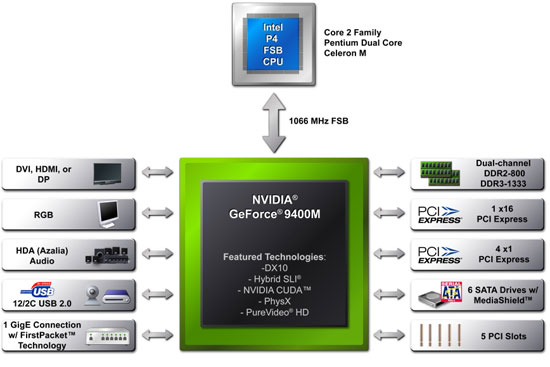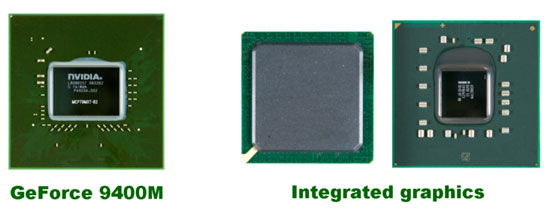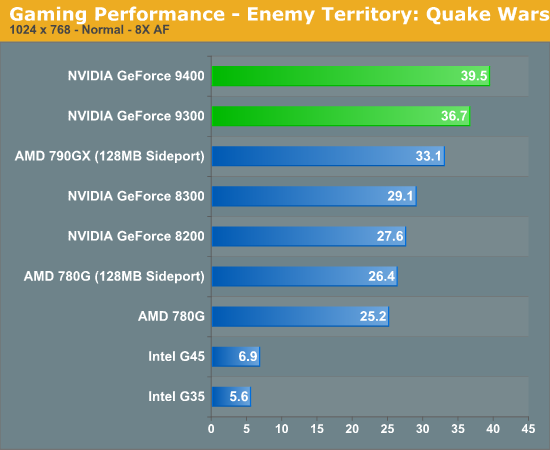Apple's Redesigned MacBook and MacBook Pro: Thoroughly Reviewed
by Anand Lal Shimpi on October 22, 2008 12:00 AM EST- Posted in
- Mac
The NVIDIA Move: The GeForce 9400M
Every now and then some interesting hardware stuff happens in the Apple world and I get all excited because I get to merge Apple coverage with PC hardware coverage; yippee.
For the uninitiated here's a quick rundown of the basic silicon in a computer: you've got a CPU, a GPU, I/O and main memory, and they all need to talk to one another. The role of the chipset is to provide some basic logic for all of these parts to communicate with one another:

Over time, more and more functionality got integrated into the chipset. Sound, video and ethernet are all part of any modern day chipset. In some cases the chipset is a combination of two chips and in others it's all one single chip.
NVIDIA used to brand its chipsets nForce and its graphics processors GeForce. When AMD bought ATI, NVIDIA realized it needed to strengthen its chipset brand so it began calling both its chipsets and graphics processors GeForce. Starting at the beginning of 2008, all NVIDIA chipsets included integrated graphics so the GeForce brand was justified.
The GeForce 9400M is the mobile variant of the GeForce 9400 chipset, which just launched last week. It's a single chip chipset with integrated graphics, giving it an inherent advantage over Intel's solution: it requires less motherboard real estate.

Intel's G35, which was used in the previous generation MacBook and MacBook Pro is composed of the G35 GMCH and the ICH9M. The GMCH was built on a 90nm process while the ICH was actually built on a 130nm process. The chips worked just fine but they consumed too much power and took up much more real estate on the motherboard. In a desktop that's not a problem, but in a notebook you're more space constrained.
NVIDIA's chipset reduces the size of the motherboard but it also reduces power consumption. Intel's G35 was built on a 90nm and 130nm process as I just mentioned; while G45 is built on 65nm for the GMCH, the ICH is still 130nm (not 90nm as I originally assumed). NVIDIA's GeForce 9400M is a 65nm chip; with good power management it should be similar in power consumption to G45 if not lower.
NVIDIA's GeForce 9400M is smaller, consumes less power than G35 and at worst the same amount of power as G45, but on top of all of that it's a lot faster than anything Intel has to offer. Take a look at this chart from last week's GeForce 9300 review:

The GeForce 9400M is far from a hardcore gaming GPU; you can't run most new games at high quality settings and get smooth frame rates, but older games will actually run relatively well on this thing. A bunch of us still play Command & Conquer 3, and instead of setting up a bunch of systems we just game on laptops. The system requirements aren't tremendous but playing on anything with G35/G45 isn't exactly satisfying; the GeForce 9400M is enough to make that game look decent and play okay. And herein lies the biggest upgrade to the new MacBook and MacBook Pro: if you happen to have Windows loaded on these machines, the gaming performance of the integrated graphics is much improved. These aren't gaming machines but they are much better than before for less stressful titles. I'd suggest looking at the GeForce 9300 review for a good idea of where NVIDIA's gaming performance stands but you're basically looking at playability at 800 x 600 or 1024 x 768 depending on the detail settings of whatever title you're playing.
Faster Exposé and Coverflow?
The GeForce 9400M, like Intel's GMA X3100 (the graphics core used in the previous generation MacBook), has no local framebuffer - instead it relies on carving out a portion of your system memory to use for its own needs. The GeForce 9400M uses the chipset's dual-channel DDR3-1066 memory controller, yielding around 17.1GB/s of memory bandwidth compared to the 10.7GB/s offered by the previous generation's dual-channel DDR2-667 memory controller.
GPU accelerated features of OS X such as Exposé and Coverflow aren't particularly processing power constrained as they ran just fine on the GMA X3100 used in the older MacBooks; memory bandwidth actually matters more here. Exposé feels slightly faster with 20 open windows on the new MacBook than on the old one; the animation is a tad smoother. The issue here is that the MacBook's resolution hasn't gone up, it's still stuck at 1280 x 800 - meaning the memory bandwidth requirements for smooth Exposé and Coverflow haven't changed. The same is true for things like Coverflow; at best it's marginally faster on the new MacBook.
Moving up to 40 windows, the gap between the GMA X3100 and the GeForce 9400M remains small but noticeable. But crank it up to 60 open windows and Exposé stutters on the GMA X3100 while it's still fairly smooth on the GeForce 9400M. I suspect this may be due to the 9400M having 256MB of system memory set aside for it compared to 144MB by the GMA X3100, although both should be able to grow their memory partition as needed without incurring a terrible penalty.
At 80 windows the GMA X3100 is unbearable when activating Exposé and both the MacBook's GeForce 9400M and the Pro's GeForce 9600M get choppy, but nowhere near as bad as the Intel solution. The 512MB GeForce 9600M will probably do a bit better with 80 windows but at 60 or less both of the NVIDIA solutions do well. With only a few windows open it's tough to tell the difference between the NVIDIA GPUs and the previous generation Intel offering, but keep a bunch of things open and you'll quickly appreciate the new mGPU.










66 Comments
View All Comments
Calin - Friday, October 24, 2008 - link
What about testing power use under XP I meanXP compares more favourably to Mac OS (or anything else) than Vista, and I wanted to know if that excessive power use is Vista-only, or if it does appear on Windows XP too
strikeback03 - Thursday, October 23, 2008 - link
Or some version of Linux?wilkinb - Wednesday, October 22, 2008 - link
yeh I agree the diff will be how the OS is set to manage each device etc etc...On my Sony laptop i get around 2 hours on high performance and a bit over 5 hours on battery saving...
The results they posted dont really tell us much other then a bootcamp vista install isnt as good as an osx install at managing power on apple laptop... amazing right?
I am sure if i dont use the Sony install and tool/drviers etc I will also get less battery life on my laptop. So the question would be do you think apple put more effort into power management on their OSX install then they did for Vista?
JarredWalton - Wednesday, October 22, 2008 - link
Let me just say that I've tried testing various power saver setting under Vista on several notebooks (see review on Friday) and I just can't get anywhere near 5 hours of battery life. Sure, the CPUs are a bit higher spec on some of the notebooks, but as one example a 12.1" laptop with 55 Whr battery, 320GB 5400RPM HDD, 4GB RAM, LED backlighting, and P8400 pulls an "amazing" 138 minutes of DVD playback and 142 minutes of web surfing... though it does manage 261 minutes when sitting idle at the desktop.As best I can tell, the CPU and HDD just don't seem to be entering sleep modes much if at all, unless the system is 100% idle. Even then, 261 minutes idle battery life doesn't compare favorably to the MacBook pulling 286 minutes of web surfing.
How big is the Sony battery, if I may ask? (Just for reference, take Voltage * mAhr to get Whr.) What sort of CPU, GPU, HDD, RAM does it use? What we need to see to prove it's possible is a Vista laptop with a 20W TDP CPU, 2GB RAM, 5400 RPM HDD, and 13.3" LED backlit LCD that can still get close to five hours of battery life with a 55 Whr battery. If you think you have one, get the manufacturer to send me one for review! :)
Spivonious - Thursday, October 23, 2008 - link
Are you guys turning off the Vista indexer and SuperFetch? Those two things would run the harddrives pretty constantly on a fresh install, which would definitely drag down battery life.JarredWalton - Thursday, October 23, 2008 - link
Do normal users disable SuperFetch? I've disabled indexing as much as I know how, since I don't use it, but SuperFetch is part of Vista. Besides, it shouldn't run on battery power (and neither should indexing).Spivonious - Friday, October 24, 2008 - link
If you want to actually test Vista battery life, install the OS and use it for a week before testing the battery life. I agree with the other poster that both the indexer and SuperFetch are great features, but they do spin the harddrive when the computer is idle until the index is built and SuperFetch learns what you use most often.Spinning harddrive = lower battery life
Comparing battery life between Vista and OS X is like comparing the time it takes to eat a pomegranate and an apple.
headbox - Saturday, October 25, 2008 - link
no, battery tests let people know how long they can use their computer without plugging it in.You're not comprehending the article- the PC laptops are also being tested at idle, just sitting there doing nothing. If Vista is going to spend that entire time "superfetching" nothing, that's a problem.
jonmcc33 - Thursday, October 23, 2008 - link
No, normal users do not disable SuperFetch. That's just bad tweaking advice, as much as turning Indexing off is as well. Both are amazing features added to Vista.I tested a Latitude D630 (2.6GHz Core 2 Duo Penryn, 2GB RAM) with Vista Business and a 9-cell 85WHr battery. Life was over 5 hours.
JarredWalton - Thursday, October 23, 2008 - link
I wouldn't be surprised if there's just some glitch on many of the laptops that's keeping battery life down, but until some manufacturer can deliver Vista with 55 Whr and 5 hours (give or take) battery life I remain skeptical. Users shouldn't have to hack their laptop in any way to get the increased battery life; it should just work properly out of the box. You know, like the MacBooks with OS X.